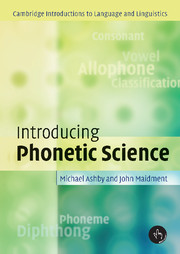7 - Airstream mechanisms
Published online by Cambridge University Press: 05 June 2012
Summary
CHAPTER OUTLINE
In this chapter you will learn about: airstream generation; egressive and ingressive flow; ejectives; implosives; clicks; non-pulmonic sounds in the world's languages.
KEY TERMS
Click
Compression
Ejective
Egressive
Glottalic
Implosive
Ingressive
Pressure
Pulmonic/nonpulmonic
Rarefaction
Velaric
Introduction
We have seen how consonant sounds can be described in terms of voice, place and manner of articulation. We now have to consider a further important way in which consonant sounds can differ from one another: the use of different airstream mechanisms. All the sounds we have dealt with up to now have used the same airstream mechanism, known as the pulmonic airstream mechanism because it uses air expelled from the lungs. In the pulmonic airstream, the lungs supply a large volume of air under pressure, enough to power the production of one or more phrase-length stretches of speech between pauses for breath. This is the basis of all normal speech in all languages, and many languages (e.g. English) make no systematic use of any other airstream. But some languages additionally make use of other airstream mechanisms for a proportion of their consonant sounds. Small volumes of air can be pushed or pulled by muscular action in the mouth or pharynx independently of the lungs, and the resulting short-term pressure differences and airflows are enough to power the production of single consonant segments, which sound recognisably different from pulmonic sounds. There are three types of consonants produced this way, known as ejectives, implosives and clicks.
- Type
- Chapter
- Information
- Introducing Phonetic Science , pp. 103 - 116Publisher: Cambridge University PressPrint publication year: 2005



